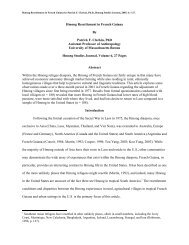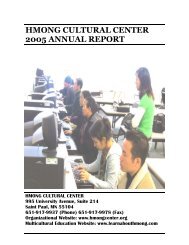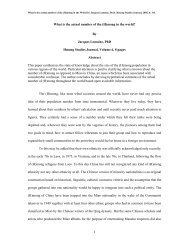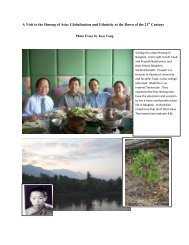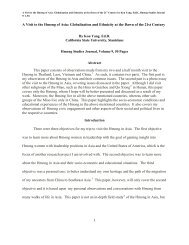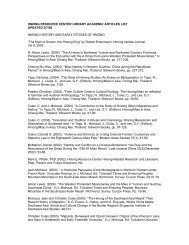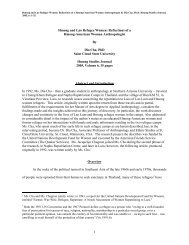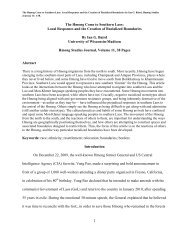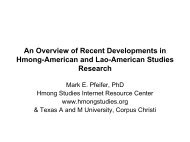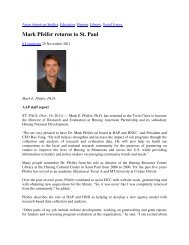Singing as Social Life - Hmong Studies Internet Resource Center
Singing as Social Life - Hmong Studies Internet Resource Center
Singing as Social Life - Hmong Studies Internet Resource Center
Create successful ePaper yourself
Turn your PDF publications into a flip-book with our unique Google optimized e-Paper software.
<strong>Singing</strong> <strong>as</strong> <strong>Social</strong> <strong>Life</strong>: Three Perspectives on Kwv Txhiaj from Vietnam by Lonán Ó Briain, <strong>Hmong</strong> <strong>Studies</strong> Journal 13.1(2012): 1-27.<br />
<strong>Singing</strong> <strong>as</strong> <strong>Social</strong> <strong>Life</strong>:<br />
Three Perspectives on Kwv Txhiaj from Vietnam<br />
By<br />
Lonán Ó Briain, Ph.D.<br />
University of Birmingham (UK)<br />
<strong>Hmong</strong> <strong>Studies</strong> Journal Volume 13(1), 27 pages<br />
Abstract<br />
Despite the recent influx of predominantly foreign-produced recordings of <strong>Hmong</strong> popular<br />
music, the vocal art form of kwv txhiaj still plays an important role in the daily lives of many<br />
Vietnamese-<strong>Hmong</strong> people. While previous studies of Vietnamese-<strong>Hmong</strong> music have tended to<br />
focus solely on the musical sounds, this article attempts to illustrate how kwv txhiaj is made<br />
meaningful in live performance by contextualizing the musical examples with ethnographic data.<br />
Using Timothy Rice’s Time, Place, and Metaphor model (2003) <strong>as</strong> a theoretical b<strong>as</strong>is, three<br />
contr<strong>as</strong>ting c<strong>as</strong>e studies of singers and their songs are examined: an elderly woman sings a song<br />
she learned at the time of her marriage at the age of nine, a younger woman sings while planting<br />
rice in her fields, and another sings about the importance of education at the local government<br />
cultural center. B<strong>as</strong>ed on fifteen months of fieldwork in northern Vietnam, this study examines a<br />
representative sample of performances from the Sa Pa district of Lào Cai province in an attempt<br />
to uncover what makes kwv txhiaj a vital <strong>as</strong>pect of Vietnamese-<strong>Hmong</strong> culture.<br />
Keywords: Vietnam, music, kwv txhiaj, subject-centered ethnography<br />
Introduction<br />
Kwv txhiaj is a traditional ballad style that is sung by <strong>Hmong</strong> people throughout the world. In<br />
Vietnam, this vocal art form is so prevalent that the term nkauj (song or singer) is often used<br />
interchangeably with kwv txhiaj in the vernacular. <strong>Studies</strong> on Vietnamese-<strong>Hmong</strong> kwv txhiaj<br />
have tended to focus on the collection of song lyrics and the categorization of songs. Since the<br />
1
<strong>Singing</strong> <strong>as</strong> <strong>Social</strong> <strong>Life</strong>: Three Perspectives on Kwv Txhiaj from Vietnam by Lonán Ó Briain, <strong>Hmong</strong> <strong>Studies</strong> Journal 13.1(2012): 1-27.<br />
1950s, Vietnamese musicologists have produced two books (Hồng 1997 1 and Dương 2010), a<br />
series of articles (e.g. Hồng 2003[1967] and 2004[1975]; Trần (2003[1968]); Trần (2003[1978]);<br />
Trịnh and Nguyễn 1978; Lương 2003[1997]), and numerous songbooks on <strong>Hmong</strong> traditional<br />
music which include extensive musical transcriptions of kwv txhiaj (e.g. Anon. 1960 and 1961;<br />
Hùng 2001, 2002, and 2003). This body of research h<strong>as</strong> been largely motivated by showing how<br />
the musical culture of the <strong>Hmong</strong> differs from that of Vietnam’s other ethnic minority groups (cf.<br />
Pelley 2002). Kwv txhiaj h<strong>as</strong> served <strong>as</strong> an ideal genre for this exercise because of its perceived<br />
historical ties with the <strong>Hmong</strong> people. The transcriptions have also been appropriated for use in<br />
compositions of nhạc dân tộc hiện đại (modern national music). 2 The logocentric approaches of<br />
these scholars, whose studies are dominated by transcriptions and include only limited<br />
descriptions and analyses of the contexts in which the musical activities took place, contr<strong>as</strong>ts<br />
with the ethnographic approach of this study.<br />
Outside of Vietnam, scholars have also devoted much time to the categorization of kwv<br />
txhiaj: Graham (1938:32) listed ten categories of kwv txhiaj which he noted among the Ch’uan<br />
Miao (<strong>Hmong</strong>) in China 3 , Mottin (1980:3-4) outlines twelve he encountered in Laos and<br />
Thailand, and Catlin (1981:8) compiled a list of seventeen which she noted among the<br />
American-<strong>Hmong</strong>. 4<br />
During fifteen months of participant-observation fieldwork in northern<br />
Vietnam between 2009 and 2011, most of the singers and instrumentalists I recorded would<br />
pause after I requested a title and then tell me that their song w<strong>as</strong> called nkauj plees (love song),<br />
1 Hồng’s book w<strong>as</strong> edited and translated into English by Nguyễn Thuyết Phong (1995).<br />
2 Nhạc dân tộc hiện đại (modern national music) is a genre of music that emerged from politicized attempts to<br />
construct a national musical heritage for Vietnam. As part of the process of inventing a national tradition<br />
(Hobsbawm 1983), some composers of nhạc dân tộc hiện đại fused compatible elements of the musics of Vietnam’s<br />
officially recognized ethnic groups together with the core traditions of the Viet majority (cf. Arana 1999).<br />
3 See Graham (1954) for an extensive collection of songs and stories from this community.<br />
4 For further readings on <strong>Hmong</strong> music outside of Vietnam see works by Eric Mareschal (e.g. 1976), Gretel<br />
Schwörer-Kohl (e.g. 1991) and Catherine Falk (e.g. 2003). A more extensive review of the literature on <strong>Hmong</strong><br />
music can be found in Ó Briain (2012:9-18).<br />
2
<strong>Singing</strong> <strong>as</strong> <strong>Social</strong> <strong>Life</strong>: Three Perspectives on Kwv Txhiaj from Vietnam by Lonán Ó Briain, <strong>Hmong</strong> <strong>Studies</strong> Journal 13.1(2012): 1-27.<br />
or, in Vietnamese, bài tình yêu. This response summarized one of the themes of the song but<br />
gave no specific details about content. While love is the most common theme of <strong>Hmong</strong> secular<br />
songs, many other types of song are used in daily life. Furthermore, kwv txhiaj songs tend to<br />
have layered meanings that shift depending on the social context. Attempts to strictly delineate<br />
categories for kwv txhiaj are problematic due to the diversity of contexts in which members of<br />
the Vietnamese-<strong>Hmong</strong> ethnic group live and use music. When I pressed my interlocutors on the<br />
subject of song categories they would begin to list daily activities such <strong>as</strong> falling in love, planting<br />
crops, drinking rice wine, and herding the water-buffalo. After a while they would inevitably<br />
break down in laughter and shake their heads, saying “many, very many”. Similarly, despite his<br />
decades of research with the <strong>Hmong</strong> in Southe<strong>as</strong>t Asia, Mottin w<strong>as</strong> unable to compile a<br />
comprehensive set of song categories. At the end of his list, Mottin indicates the limitations of<br />
his categories by writing “and many more…” (1980:4). The imposition of categories and<br />
subcategories by non-<strong>Hmong</strong> scholars on this genre h<strong>as</strong> not produced conclusive results due to<br />
the diversity of contexts in which kwv txhiaj is performed; the categories depend on the social<br />
contexts of the performances and are therefore constantly in flux. The song titles used in this<br />
article should be understood <strong>as</strong> describing the theme of the song that w<strong>as</strong> most prevalent during<br />
the recorded rendition, and on other occ<strong>as</strong>ions the performer might give preference to one or<br />
more other themes.<br />
This article contr<strong>as</strong>ts with most Vietnamese scholarship on <strong>Hmong</strong> music by considering<br />
the perspectives of the people taking part in the musical activities rather than simply examining<br />
the musical sounds. Three women 5 and the kwv txhiaj songs that each of them sang for me are<br />
5 While I found that the sphere of traditional instrumental music w<strong>as</strong> largely dominated by men, Vietnamese-<strong>Hmong</strong><br />
women tended to be much more comfortable singing in public than men. Mottin found that <strong>Hmong</strong> women also<br />
tended to dominate the world of singing in public in Laos and Thailand, and most of his book on singing is devoted<br />
to songs that were sung by women (1980). In Bulgaria, Rice notes a similar division in gender roles with regard to<br />
3
<strong>Singing</strong> <strong>as</strong> <strong>Social</strong> <strong>Life</strong>: Three Perspectives on Kwv Txhiaj from Vietnam by Lonán Ó Briain, <strong>Hmong</strong> <strong>Studies</strong> Journal 13.1(2012): 1-27.<br />
introduced in an attempt to undercover some of the ways that singers make kwv txhiaj<br />
meaningful in live performance. Structured by Rice’s “Time, Place and Metaphor” model<br />
(2003), the investigation focuses on how the meanings of the songs have changed for and been<br />
changed by these individuals at various times and places in their lives. This approach seeks to<br />
derive a set of overarching metaphors about the fundamental nature of music for these women.<br />
While the focus is on individuals in the community, each individual c<strong>as</strong>e is considered <strong>as</strong> “a<br />
thoroughly social self <strong>as</strong> it emerges from and reattaches itself to an emergent array of social units<br />
and communities” (Rice 2010:109 fn. 15). Ultimately, the aim is to enhance our understanding of<br />
traditional forms of musical activity in rural <strong>Hmong</strong> communities in Vietnam.<br />
The kwv txhiaj style forms the foundation of <strong>Hmong</strong> traditional music theory, and most<br />
<strong>Hmong</strong> traditional instrumental music is b<strong>as</strong>ed on its structures. Gisa Jähnichen, who conducted<br />
research on kwv txhiaj in Laos, observes:<br />
Very interesting is the general characteristic of generating absolutely individual melodic<br />
lines. In each example and in all the other recordings there w<strong>as</strong> no one song with a repetition<br />
of a single melodic line. Avoiding repetitions is therefore a remarkable sign of <strong>Hmong</strong> song<br />
melodies. (2006:210)<br />
In China, Agnew similarly noted “a marked lack of precision in the rhythm, and this leads to<br />
considerable difficulty in the recording of the songs” (1939:19). The melodies of kwv txhiaj are<br />
shaped according to the word tones of the <strong>Hmong</strong> language. While improvised or extemporized<br />
wordplay is one of the fundamental traits of the song style, singers should adhere to the txwm<br />
(rhyming couplets) at the beginning of phr<strong>as</strong>es. Adjacent phr<strong>as</strong>es tend to be of unequal length<br />
traditional singing practices; he suggests that men usually only sing when drunk or pretending to be because they do<br />
not want to outwardly display any emotions (1994:124). I consider the division of roles by gender in musical<br />
activities at greater length in my PhD dissertation (see Ó Briain 2012).<br />
4
<strong>Singing</strong> <strong>as</strong> <strong>Social</strong> <strong>Life</strong>: Three Perspectives on Kwv Txhiaj from Vietnam by Lonán Ó Briain, <strong>Hmong</strong> <strong>Studies</strong> Journal 13.1(2012): 1-27.<br />
because they depend on the wordplay of the singer. As with phr<strong>as</strong>e lengths and rhythms, the<br />
scales employed by singers, although typically pentatonic or tetratonic, also tended to vary in<br />
pitch by region because they were b<strong>as</strong>ed on local linguistic dialects. 6<br />
Rice’s model for subject-centered ethnographies is an ideational space that considers data<br />
on three dimensions: time, place, and metaphor. Since “we and our subjects experience music<br />
socially in multiple locales” (Rice 2003:160), place is conceptualized <strong>as</strong> a sociogeographic<br />
dimension in his model. Suggested nodes for this “projection of the social in space” (ibid.:159)<br />
include, but are not limited to: individual, subcultural, local, regional, national, areal, di<strong>as</strong>poric,<br />
global, and virtual (ibid.:161). Time is considered on two planes: chronologically and<br />
experientially or phenomenologically. Both of these planes must be considered when plotting the<br />
place nodes because they help define the sociogeographic context. The metaphors of Rice’s<br />
model are concepts of what music is. Suggested metaphors include music <strong>as</strong> art, music <strong>as</strong> social<br />
behavior, music <strong>as</strong> symbolic system or referential text, and music <strong>as</strong> commodity (ibid.:166-67).<br />
These are intended <strong>as</strong><br />
fundamental claims to truth, guides to practical action and sources for understanding music's<br />
profound importance in human life. Rather than true or false, each claim... is merely limited,<br />
one of many possibilities. A given metaphor probably achieves some goals and makes some<br />
sense in certain situations but fails to account for the full range of music’s possibilities and<br />
significance. I further suggest that multiple musical metaphors probably guide action and<br />
thought in individual lives, in society and through time. Sometimes... they happily<br />
commingle; at others they may become alternative, competing strategies. (2001:22)<br />
Some of the metaphors discussed in this article were verbalized by the people themselves while<br />
others were interpreted by the author b<strong>as</strong>ed on stories told by the singers relating to the music<br />
and the time and place nodes which they generated.<br />
While I met, interviewed, and recorded many <strong>Hmong</strong> women between 2009 and 2011<br />
this article only considers a representative sample of these. All three recordings were made by<br />
6 See Mottin (1980) for a comprehensive analysis of the kwv txhiaj style and Poss (2012) for an examination of the<br />
relationship between <strong>Hmong</strong> linguistic tones and musical phr<strong>as</strong>es.<br />
5
<strong>Singing</strong> <strong>as</strong> <strong>Social</strong> <strong>Life</strong>: Three Perspectives on Kwv Txhiaj from Vietnam by Lonán Ó Briain, <strong>Hmong</strong> <strong>Studies</strong> Journal 13.1(2012): 1-27.<br />
the author in the Sa Pa district of Lào Cai province during this period. After returning from the<br />
field, the individual c<strong>as</strong>es were selected b<strong>as</strong>ed on a number of similarities and differences<br />
between them. To highlight some of the more significant of these traits: the similarities or<br />
sameness of gender, ethnicity, geographic location (in some part of the Sa Pa district), and<br />
traditional song style bind them; the differences of age (young adult, middle-aged adult, and<br />
elderly adult), song text subject, and status <strong>as</strong> amateur or professional 7<br />
musicians serve to<br />
provide contr<strong>as</strong>t. This balance between sameness and difference serves to highlight the diversity<br />
of traditional songs and singing practices within one <strong>Hmong</strong> community in Vietnam. The aim is<br />
to demonstrate the variety of contexts in which <strong>Hmong</strong> songs thrive and to find out what makes<br />
these musical activities meaningful to the participants.<br />
C<strong>as</strong>e Study One: The Nine-Year-Old Bride<br />
While the <strong>Hmong</strong> have always been noted for their free and open relations between the sexes by<br />
comparison with the strict and formal hierarchical society of the Kinh Vietnamese, a <strong>Hmong</strong><br />
wedding ceremony traditionally forms a bond not only between two people but also between two<br />
lineages. 8 Before a wedding, the two families meet to agree on compensation in the form of<br />
money, farm animals, clothes, and jewelry such <strong>as</strong> silver coins from French colonial times or<br />
handmade necklaces (xauv). Kinship relationships in <strong>Hmong</strong> society are b<strong>as</strong>ed on patrilineal<br />
descent. Typically, after marriage the bride moves into the groom’s house and becomes a<br />
member of his family. Her family by birth must be compensated adequately for their loss. The<br />
amount depends on the woman’s standing in the community; if she is young, healthy, and likely<br />
to bear many children the price could be <strong>as</strong> much <strong>as</strong> twenty million VNĐ ($960) plus extr<strong>as</strong><br />
7 There are very few professional <strong>Hmong</strong> singers in Vietnam. However, the third c<strong>as</strong>e study in this article<br />
demonstrates how one <strong>Hmong</strong> woman h<strong>as</strong> been able, albeit sporadically, to supplement her income through singing<br />
and working <strong>as</strong> a cultural representative for the Vietnamese-<strong>Hmong</strong> people.<br />
8 There are certain special forms of marriage including marriage by capture and marriage by elopement which are<br />
designed to escape this traditional approach and can be used when a couple falls in love.<br />
6
<strong>Singing</strong> <strong>as</strong> <strong>Social</strong> <strong>Life</strong>: Three Perspectives on Kwv Txhiaj from Vietnam by Lonán Ó Briain, <strong>Hmong</strong> <strong>Studies</strong> Journal 13.1(2012): 1-27.<br />
including large farm animals but if she h<strong>as</strong> been married previously or h<strong>as</strong> some other social<br />
handicap the bride price could be <strong>as</strong> low <strong>as</strong> one million VNĐ ($48) with a few small farm<br />
animals. When a wife moves to her husband’s house she h<strong>as</strong> to take on many new<br />
responsibilities including household chores such <strong>as</strong> cooking for her new extended family,<br />
cleaning the house, and embroidering and w<strong>as</strong>hing clothes. The stresses of this transition period<br />
can be compounded by her unfamiliarity with the other people in the house and their lack of<br />
sympathy for her. For these re<strong>as</strong>ons, and in contr<strong>as</strong>t to many wedding cultures in other parts of<br />
the world, typically, a Vietnamese-<strong>Hmong</strong> bride will be very upset on her wedding day.<br />
When I interviewed Mu Xiong (Figure 1), an elderly woman from Séo Mí Tỉ village, she<br />
chose to sing two songs for me: a daughter-in-law’s song (nkauj ua nyab), which she learned at<br />
the time of her marriage, and a funeral song (nkauj tuag), which she dedicated to her late<br />
husband. Mu w<strong>as</strong> born in the year of the pig, probably 1923, thus making her one of the eldest<br />
consultants who took part in this study. Before Mu w<strong>as</strong> married she used to play nplooj (leaf)<br />
very well and even claimed that she could play qeej, an instrument that is now considered only<br />
for men. The marriage arrangements were made by her parents and she had never met her<br />
husband before the wedding day. After she married she w<strong>as</strong> too busy with her work <strong>as</strong> a<br />
housewife and a daughter-in-law to make time for playing music. Occ<strong>as</strong>ionally she would play<br />
when alone but her husband discouraged her from doing so because he did not understand why a<br />
woman would want to play music <strong>as</strong> it only took away from the time she could be doing more<br />
practical housework. By the time her children had grown up she had forgotten how to play and<br />
decided to give away her instruments.<br />
7
<strong>Singing</strong> <strong>as</strong> <strong>Social</strong> <strong>Life</strong>: Three Perspectives on Kwv Txhiaj from Vietnam by Lonán Ó Briain, <strong>Hmong</strong> <strong>Studies</strong> Journal 13.1(2012): 1-27.<br />
Figure 1: Mu Xiong watches herself singing on camcorder with the author, 16 June 2010. Photograph by<br />
Bernhard Huber.<br />
After the early challenges of her marriage Mu clearly grew to love her husband dearly.<br />
Her husband w<strong>as</strong> a shaman who p<strong>as</strong>sed away over thirty years ago. When recalling him in<br />
conversation she had to hold back the tears. They had eleven boys and two girls together. Mu<br />
estimated her extended family comprised <strong>as</strong> many <strong>as</strong> three hundred people, and others who knew<br />
her in the area supported this claim. Aside from her social position <strong>as</strong> a widowed grandmother of<br />
an extensive family, Mu w<strong>as</strong> important to the local community <strong>as</strong> an expert in herbal medicine—<br />
the skill of being able to “divide the spirits of herbal medicine” (faib dab tshuaj; Lee and Tapp<br />
2010:29) tends to be part of the shaman’s skill set but this is not always the c<strong>as</strong>e.<br />
8
<strong>Singing</strong> <strong>as</strong> <strong>Social</strong> <strong>Life</strong>: Three Perspectives on Kwv Txhiaj from Vietnam by Lonán Ó Briain, <strong>Hmong</strong> <strong>Studies</strong> Journal 13.1(2012): 1-27.<br />
Despite the strong bond of love between Mu and her husband which developed after<br />
years of marriage, in the days leading up to her wedding, when she w<strong>as</strong> only nine years old, Mu<br />
said she w<strong>as</strong> extremely sad. In order to raise her spirits and help her overcome the challenges she<br />
would face when she first moved into her husband’s home, her grandmother by birth taught her a<br />
song about marriage. 9 Mu said this song made her feel strong when she sang it and she wished to<br />
sing it for me so that it might be preserved for her children and grandchildren to learn.<br />
Tav ntuj t<strong>as</strong> tav laus n<strong>as</strong> es yos,<br />
Kuv leej txheeb nus ntshaw luag tus nyuj<br />
pwm i rov kaus laus,<br />
Muab kuv qua plhuav lawm tej teb i kab kis<br />
zaub n<strong>as</strong>,<br />
Kuv leej nam leej txiv yuav ntshaw luag tus<br />
nyuj pwm i rov nkhaus raws,<br />
Muab kuv qua plhuav tej teb i kab kis taws<br />
ntuj teb,<br />
Kuv de zaub tsis muaj zaub daus kub khaws<br />
taw tsis muaj es laus,<br />
Kuv kuv tau daus xib daus npu yaj yaws txij<br />
qhov raws,<br />
Nes leej nam nes yem yos,<br />
Kuv tsis tau kev tseb maj tag kuv tseb maj<br />
tag txuj kev deb.<br />
Hmoob txwg Vaj laus tau kuv lub kwm maj<br />
tag kawm kuv lub kawm maj tag daus deb.<br />
Now I am old and have lived a long life,<br />
Long ago when I w<strong>as</strong> very young my dear<br />
family needed a buffalo,<br />
So I w<strong>as</strong> used <strong>as</strong> dowry and had to travel far<br />
to a place I had never been before,<br />
I married and my family received the animal<br />
in payment, it w<strong>as</strong> very hard for me,<br />
I had to go so far into the mountains to<br />
gather firewood in this new place,<br />
Sometimes walking through the snow, with<br />
it up to my calves,<br />
And I had to get food for the pig, even<br />
though the ground w<strong>as</strong> frosted over,<br />
It w<strong>as</strong> really difficult for me,<br />
I had to go far to plant hemp but the land<br />
w<strong>as</strong> not good and had many stones and<br />
rocks.<br />
My family sent me to marry very far away<br />
and I carried a heavy bag on my back and<br />
cried with sadness.<br />
9 A video recording of this song can be accessed at: https://vimeo.com/41665694.<br />
9
<strong>Singing</strong> <strong>as</strong> <strong>Social</strong> <strong>Life</strong>: Three Perspectives on Kwv Txhiaj from Vietnam by Lonán Ó Briain, <strong>Hmong</strong> <strong>Studies</strong> Journal 13.1(2012): 1-27.<br />
Excerpt from the lyrics of Mu Xiong’s nkauj ua nyab. 10<br />
The lyrics of the version sung by Mu have clearly changed significantly from the version<br />
her grandmother taught her. While Mu described her grandmother’s version <strong>as</strong> though it w<strong>as</strong> a<br />
form of social education or therapy, the version she sang for me might be best described with the<br />
metaphor of music <strong>as</strong> memoir <strong>as</strong> she recounted the hardships she endured after her marriage<br />
including the difficulties she had in planting hemp, the birth of a child, the inability of her small<br />
child to provide <strong>as</strong>sistance to her, and her difficulty with using the loom and its component parts.<br />
Unfortunately there is no recording of her grandmother’s rendition to make more conclusive<br />
statements about the nature of musical change <strong>as</strong> it pertains to this song.<br />
Chau Hang, a research <strong>as</strong>sistant who helped me interview Mu Xiong, provided some<br />
interesting insights on the performance. Although Chau is not an expert in kwv txhiaj, her views<br />
are important to consider because they represent a large proportion of <strong>Hmong</strong> youth in Vietnam<br />
who are untrained in the art of the kwv txhiaj. Chau thought that I should not include this<br />
recording in my study because the form of the song “does not make sense”. As is evident when<br />
comparing this song to the transcribed lyrics in the third c<strong>as</strong>e study, the form of the latter song<br />
more closely resembles binary form which is related to the fixed texts of popular songs in versechorus<br />
form. 11 Chau, who h<strong>as</strong> lived in Vietnam her entire life, is explicitly aware of how <strong>Hmong</strong><br />
culture h<strong>as</strong> been portrayed <strong>as</strong> lacking in sophistication in the national media. In her opinion, the<br />
inclusion of this song would reinforce those stereotypes because she does not believe that the<br />
10 I am sincerely grateful to Chau Hang, Choua Lee, Lang Yang, and Chi Yang who <strong>as</strong>sisted with the transcription<br />
and translation of these song texts. Any remaining errors in the text are solely the responsibility of the author. As I<br />
chose to transcribe the songs using <strong>Hmong</strong> RPA instead of the Viet-<strong>Hmong</strong> script, I encountered many difficulties<br />
with the transcription and translation of the texts. Few <strong>Hmong</strong> in Vietnam are fluent in either script because neither<br />
is taught above an elementary level in formal education. For those wishing to access the complete songs ple<strong>as</strong>e see<br />
the recordings.<br />
11 See Ó Briain (Forthcoming) for an examination of the impact of foreign-produced <strong>Hmong</strong> popular music<br />
recordings on Vietnamese-<strong>Hmong</strong> culture and society.<br />
10
<strong>Singing</strong> <strong>as</strong> <strong>Social</strong> <strong>Life</strong>: Three Perspectives on Kwv Txhiaj from Vietnam by Lonán Ó Briain, <strong>Hmong</strong> <strong>Studies</strong> Journal 13.1(2012): 1-27.<br />
extemporized form of the song can compete with the fixed texts of popular songs in verse-chorus<br />
form which she regularly listens to. Instead, Chau thought I should use songs in verse-chorus<br />
form and which were sung by professional <strong>Hmong</strong> pop stars from other countries such <strong>as</strong> the<br />
recordings that were available on YouTube. Her wish for <strong>Hmong</strong> music to be represented by<br />
these songs suggests a change in aesthetic t<strong>as</strong>te that relates to fixed versions of the text and also<br />
demonstrates her own emph<strong>as</strong>is on the song lyrics rather than the singer, the social context and<br />
the art of improvised wordplay.<br />
By shifting the focus to the singer instead of the song, however, in much the same way <strong>as</strong><br />
Warner (1994) does for the tellers of folktales, we can understand how kwv txhiaj songs are<br />
manipulated through time and space in a similar way to other folklore. Now, the “imperfections”<br />
can be reinterpreted <strong>as</strong> participatory discrepancies (Keil 1987) which highlight the personality<br />
behind each specific rendition of the song. At this particular time and place, Mu Xiong’s<br />
emph<strong>as</strong>is on recounting an episode from her life through song, thereby applying the metaphor of<br />
music <strong>as</strong> memoir, takes precedence over the desire to adhere closely to the traditional song form.<br />
In his collection of fifty-five <strong>Hmong</strong> songs gathered in Laos and Thailand Jean Mottin<br />
includes five examples of nkauj ua nyab (1980:44-61). As long <strong>as</strong> these marriage practices<br />
continue to be an important part of Vietnamese-<strong>Hmong</strong> social structure, this song style will<br />
maintain its relevance to the community and therefore be sustained <strong>as</strong> a tradition. But <strong>as</strong> these<br />
cultural practices become less commonplace, <strong>as</strong> h<strong>as</strong> begun to occur in certain parts of Vietnam,<br />
this song style will become obsolete and merely function <strong>as</strong> an historical record of p<strong>as</strong>t<br />
traditions.<br />
This c<strong>as</strong>e study h<strong>as</strong> demonstrated how Mu Xiong’s experience of music and of one<br />
particular song h<strong>as</strong> changed through her life. From her description of the version taught to her by<br />
11
<strong>Singing</strong> <strong>as</strong> <strong>Social</strong> <strong>Life</strong>: Three Perspectives on Kwv Txhiaj from Vietnam by Lonán Ó Briain, <strong>Hmong</strong> <strong>Studies</strong> Journal 13.1(2012): 1-27.<br />
her grandmother and her framing of the recorded rendition, the metaphors of music <strong>as</strong> social<br />
education or therapy could be interpreted for the former and music <strong>as</strong> memoir summarizes the<br />
essence of the latter version. For Mu Xiong, then, singing this song makes sense of her life cycle<br />
and in this way her musical activities can be understood <strong>as</strong> a fundamental <strong>as</strong>pect of her lived<br />
experience.<br />
C<strong>as</strong>e Study Two: The Horticultural Lover<br />
This c<strong>as</strong>e study presents a song which is paired with two types of cycles: the agricultural cycle<br />
and the life cycle. The lives of most Vietnamese-<strong>Hmong</strong> are shaped by the agricultural calendar.<br />
In Sa Pa, wet-rice cultivation on terraced fields is and h<strong>as</strong> been for a long time the primary<br />
means of subsistence for the <strong>Hmong</strong> (c.f. Savina 1924; Michaud 1999:3). Rice, corn, hemp, and<br />
other crops must be planted at the appropriate times of the se<strong>as</strong>on. Neighboring households help<br />
each other when planting so that each terraced field is planted at the most fertile time. The<br />
importance of this communal work and of knowledge about these practices h<strong>as</strong> resulted in many<br />
musical activities relating to this way of life. The primary medium for sustaining knowledge<br />
about these local practices continues to be through folklore, including songs.<br />
In June 2010, Chi Yang and I travelled to Sử Pán village to visit the singer Mu Yang<br />
(born 1974). Mu w<strong>as</strong> a neighbor and friend of Chi’s whom I had met previously. When we<br />
arrived at her house that day the entire family w<strong>as</strong> out planting rice in their fields. The older boys<br />
were guiding a water buffalo with a plough through the rice-paddies while the younger children<br />
were playing around and p<strong>as</strong>sively observing and learning from their elders. Mu’s husband w<strong>as</strong><br />
sprinkling feed in the fields that had been ploughed while Mu w<strong>as</strong> following behind and planting<br />
the rice stalks. Chi and I offered to help Mu planting the stalks while Mu entertained us by<br />
12
<strong>Singing</strong> <strong>as</strong> <strong>Social</strong> <strong>Life</strong>: Three Perspectives on Kwv Txhiaj from Vietnam by Lonán Ó Briain, <strong>Hmong</strong> <strong>Studies</strong> Journal 13.1(2012): 1-27.<br />
singing a song about planting rice which Chi found humorous (see Figure 2). 12 I recorded five<br />
separate stanz<strong>as</strong> while in the fields with Mu. As with Mu Xiong, Mu Yang’s performance w<strong>as</strong><br />
extemporized and included long breaks between each section while she coordinated the workers.<br />
This performance exemplifies some of the fundamental characteristics of the kwv txhiaj<br />
song style. As is typical of the style, Mu begins with a sustained upper tonic (Figure 2). On this<br />
note she pronounces “tab” (“but”) which does not contribute to the meaning of the remainder of<br />
the phr<strong>as</strong>e but is vital to the kwv txhiaj style because it forms a txwm with the second line, <strong>as</strong> the<br />
third and fourth lines also do. The transcription also illustrates how the tones of the <strong>Hmong</strong><br />
language shape but do not necessarily fix the melodic line. Note how the “j” (high falling) and<br />
“m” (glottal restriction/low falling) tones appear when the melody is descending and the “v”<br />
(rising) tone tends to appear when the melody is rising. The “b” (high) tone tends to occur on<br />
higher notes while the “g” (breathy/mid-low) tone tends to occur in the middle of the scale. The<br />
“s” (low) tone also tends to appear around the middle of the scale in the transcribed section.<br />
While this l<strong>as</strong>t tone might seem out of place since one would not normally describe the E or G <strong>as</strong><br />
“low”, in this context the absence of a low A on any strong half-beat of the melody, <strong>as</strong>ide from<br />
the l<strong>as</strong>t note of the phr<strong>as</strong>es each time, demonstrates how this bottom note is rarely used while the<br />
line is moving. The tendency to avoid consecutive repetition of the same melody notes and the<br />
use of a tetratonic scale challenge the singer to match the linguistic tones with the pitch tones<br />
while also singing lyrics which are comprehensible to the listener and fit into the txwm rhyming<br />
couplet structure.<br />
12 A video recording of this song can be accessed at: https://vimeo.com/41693572.<br />
13
<strong>Singing</strong> <strong>as</strong> <strong>Social</strong> <strong>Life</strong>: Three Perspectives on Kwv Txhiaj from Vietnam by Lonán Ó Briain, <strong>Hmong</strong> <strong>Studies</strong> Journal 13.1(2012): 1-27.<br />
Figure 2: A transcription of the first four phr<strong>as</strong>es of Mu Yang’s nkauj cog nplej. 13<br />
In an essay on the “mental world of the unenlightened during the Enlightenment”<br />
(1984:9), the cultural historian Richard Darnton argues that “the great collections of folktales<br />
made in the late nineteenth and early twentieth centuries... provide a rare opportunity to make<br />
contact with the illiterate m<strong>as</strong>ses who have disappeared into the p<strong>as</strong>t without leaving a trace”<br />
(ibid.:17-18). The fixity of the written collections he analyses belies the diversity of versions that<br />
would likely have been found within any one community or even told by one individual, <strong>as</strong><br />
demonstrated in the previous c<strong>as</strong>e study. Nevertheless, in showing how the worldviews of the<br />
pe<strong>as</strong>ants who told these tales were embedded in the stories themselves, Darnton is able to<br />
13 This transcription is approximately one semitone higher than the actual pitch which Mu sings at in order to avoid<br />
the use of excessive accidentals.<br />
14
<strong>Singing</strong> <strong>as</strong> <strong>Social</strong> <strong>Life</strong>: Three Perspectives on Kwv Txhiaj from Vietnam by Lonán Ó Briain, <strong>Hmong</strong> <strong>Studies</strong> Journal 13.1(2012): 1-27.<br />
reconstruct their world, albeit fragmentarily. This approach takes the metaphor of fairy tale <strong>as</strong><br />
social behavior for granted.<br />
Where the metaphor of singing <strong>as</strong> social behavior is most prevalent, <strong>Hmong</strong> songs can<br />
similarly be used <strong>as</strong> a means of understanding <strong>Hmong</strong> worldviews. On its most b<strong>as</strong>ic level, the<br />
text of this song transmits knowledge about the importance of planting at the right time so that<br />
the crops will yield a good harvest: “Oh my darling, we are planting late in the se<strong>as</strong>on, but the<br />
seeds should grow strong anyway.” At this level of understanding, the song could also be<br />
categorized <strong>as</strong> a work song, functioning “<strong>as</strong> an extension of our bodies doing things in the world<br />
around us” (Gioia 2006:38). The steady pulse of the song accompanies the actions of the planters<br />
<strong>as</strong> one by one, tens of thousands of rice shoots are carefully placed in the muddy water of the<br />
rice-paddies.<br />
One limitation of Darnton’s textual analysis is its lack of contextual details relating to the<br />
performance of the fairy tales. This is where the metaphors are generated and manipulated<br />
strategically by the skilled performer. A closer analysis of Mu Yang’s performance reveals layers<br />
of linguistic meaning which suggest that she is applying multiple metaphors in the one<br />
performance. Through wordplay she uses agricultural production <strong>as</strong> a metaphor for sexual<br />
reproduction. For example, the word “coj” h<strong>as</strong> multiple meanings in the <strong>Hmong</strong> language such<br />
<strong>as</strong> to deliver, plant or take, or to suggest a change or transition, while it also forms part of the<br />
compound word “coj khaub ncaws” (“to menstruate”). In her singing, Mu takes advantage of the<br />
ambiguity of this and other words to communicate multiple linguistic meanings; in particular, the<br />
fertile ground could be interpreted <strong>as</strong> a fertile womb and the seeds or grain could also be<br />
referring to a man’s semen. Hence, Chi’s laughter while Mu w<strong>as</strong> singing.<br />
15
<strong>Singing</strong> <strong>as</strong> <strong>Social</strong> <strong>Life</strong>: Three Perspectives on Kwv Txhiaj from Vietnam by Lonán Ó Briain, <strong>Hmong</strong> <strong>Studies</strong> Journal 13.1(2012): 1-27.<br />
This alternative demonstrates how Mu Yang h<strong>as</strong> maximised the impact of her<br />
performance through her capacity to communicate on multiple plains. For the location dimension<br />
of his model, Rice suggests the following nodes: individual, subcultural, local, regional, national,<br />
areal, di<strong>as</strong>poric, global, and virtual (2003:161). Primarily, these nodes relate to how individuals<br />
experience music socially rather than simply delineating the geographic locale in which those<br />
experiences took place. An alternative set of nodes are suggested by Mu Yang’s singing which<br />
highlight the social <strong>as</strong>pect of the location dimension: communication with her children, with her<br />
fellow adults and, more intimately, with her husband. These nodes illustrate how multiple<br />
overlapping metaphors are being deployed in the same performance. With her children, the song<br />
text communicates knowledge about planting. For them, the metaphors of singing <strong>as</strong> education,<br />
<strong>as</strong> knowledge transfer, and <strong>as</strong> work come to the fore. Her performance functions largely <strong>as</strong><br />
entertainment and <strong>as</strong> an accompaniment to work for the older children and adults present. The<br />
admiration shown for her by those listeners, <strong>as</strong> evidenced by their tacit observation and<br />
occ<strong>as</strong>ional laughter, also helps position Mu socially <strong>as</strong> a respected adult in the community.<br />
Finally, with her husband, the song could also be considered <strong>as</strong> flirtation or foreplay. 14<br />
The impact of Mu Yang’s performance could be me<strong>as</strong>ured by the degree of success in her<br />
communication of these metaphors (music <strong>as</strong> education, knowledge transfer, social behavior,<br />
work, entertainment or foreplay) to their intended audience. The hierarchy of these metaphors<br />
must be in perpetual negotiation by the performer according to the shifting time and place nodes.<br />
Ultimately, the impact depends on how well the performer understands and responds to these<br />
changing nodes. These layered metaphors illustrate the limitations of applying definitive song<br />
14 This is by no means a comprehensive list and only represents those metaphors that were most evident during the<br />
performance I observed. Rice’s metaphor of music <strong>as</strong> social behaviour appears to dominate this list. Considering my<br />
position <strong>as</strong> outside observer, Mu might also have preferred to think of her performance <strong>as</strong> a representation of her<br />
family and of her love for her husband.<br />
16
<strong>Singing</strong> <strong>as</strong> <strong>Social</strong> <strong>Life</strong>: Three Perspectives on Kwv Txhiaj from Vietnam by Lonán Ó Briain, <strong>Hmong</strong> <strong>Studies</strong> Journal 13.1(2012): 1-27.<br />
categories to kwv txhiaj. While this song is ostensibly about planting, it might also be called a<br />
love song or a work song, among other themes, depending on the interpretation of the listener.<br />
This c<strong>as</strong>e study h<strong>as</strong> illustrated some of the b<strong>as</strong>ic characteristics of the kwv txhiaj style and<br />
demonstrated how layers of ambiguous meaning in the lyrics can permit the application of<br />
multiple musical metaphors in one seemingly uncomplicated performance of a song. Mu Yang’s<br />
ability <strong>as</strong> a singer provides a certain degree of social status through her ability to garner the tacit<br />
positive attention of multiple social groups simultaneously. Her singing motivates those around<br />
her to <strong>as</strong>sist with planting rice through her ability to communicate on various levels to a diverse<br />
group of family and friends. In doing so, she forms a working community through song.<br />
C<strong>as</strong>e Study Three: The Cultural Amb<strong>as</strong>sador<br />
While the first two c<strong>as</strong>e studies presented more typical types of kwv txhiaj, this c<strong>as</strong>e study<br />
considers a song that is <strong>as</strong>sociated with a comparatively new type of activity for many<br />
Vietnamese-<strong>Hmong</strong> people, going to school. This c<strong>as</strong>e demonstrates how kxv txhiaj songs can<br />
adapt to new forms of behavior and new activities. Furthermore, it shows how the meaning of a<br />
the song can change for the singer <strong>as</strong> her performance locale shifts from local to regional,<br />
national, global, and virtual.<br />
I w<strong>as</strong> introduced to Sung Thao through her son, Sai Yang. Unusually for a <strong>Hmong</strong> man,<br />
Sai studied for a university degree in Hanoi. He w<strong>as</strong> teaching the b<strong>as</strong>ics of <strong>Hmong</strong> traditional<br />
music to friends of mine at the National Academy of Music when I met him. When I first visited<br />
their house on the outskirts of Sa Pa town, Sung’s husband Ga Yang did most of the talking.<br />
Despite developing a close friendship with her son and making regular visits to their house, this<br />
social dynamic continued throughout my fieldwork; <strong>as</strong> with many other Asian societies,<br />
patriarchy is the dominant social system for the Vietnamese-<strong>Hmong</strong>. In Sung’s house this<br />
17
<strong>Singing</strong> <strong>as</strong> <strong>Social</strong> <strong>Life</strong>: Three Perspectives on Kwv Txhiaj from Vietnam by Lonán Ó Briain, <strong>Hmong</strong> <strong>Studies</strong> Journal 13.1(2012): 1-27.<br />
hierarchy w<strong>as</strong> exaggerated by Ga’s professional position <strong>as</strong> director of the Sa Pa Cultural <strong>Center</strong><br />
(Phó Giám đốc Trung tâm Văn hoá Sa Pa). Led by Ga, their family frequently took part in<br />
cultural performances locally in Sa Pa, occ<strong>as</strong>ionally in the major urban centers of Hanoi and Ho<br />
Chi Minh City and once in southern China. 15<br />
When Sung w<strong>as</strong> not working <strong>as</strong> a cultural<br />
amb<strong>as</strong>sador, she sold textiles in the local market. For this work she had to be proficient in both<br />
the Vietnamese and <strong>Hmong</strong> languages. However, in a documentary film in which Sung sings two<br />
songs and introduces one (Nghệ Nhân Giàng Seo Gà: Phim Thuộc Dự Án Sưu Tầm, Bảo Tồn,<br />
Âm Nhạc Dân Gian Của Gia Đình Nghệ Nhân Giàng Seo Gà, Dân Tộc Mông, Sa Pa, Lào Cai<br />
[The Artist Giang Seo Ga: A Film to Collect and Preserve the Folk Music of the Artist Ga Yang<br />
and his Family, in Sa Pa, Lao Cai] 2004), she speaks in <strong>Hmong</strong> and her husband translates into<br />
Vietnamese. A similar performance of the patriarchal social structure w<strong>as</strong> enacted when I<br />
requested to meet Sung for a formal interview and to record her singing.<br />
By January 2011 I had given up trying to get to know Sung informally because the<br />
18
<strong>Singing</strong> <strong>as</strong> <strong>Social</strong> <strong>Life</strong>: Three Perspectives on Kwv Txhiaj from Vietnam by Lonán Ó Briain, <strong>Hmong</strong> <strong>Studies</strong> Journal 13.1(2012): 1-27.<br />
tempered and lacking in enthusi<strong>as</strong>m compared to other singers I had heard: the tempo w<strong>as</strong><br />
slower, the volume w<strong>as</strong> lower and the song w<strong>as</strong> shorter than any other I recorded. As is evident<br />
from the lyrics of this song, the theme and content also contr<strong>as</strong>ted with the majority of songs I<br />
had recorded. This made me consider why she had chosen this particular song.<br />
Yuav am ntuj, teb ncua nes kwv tij, kwv viv luag<br />
niam, h<strong>as</strong> am.<br />
Yuav ca teb, li hnov phau ntawv xwb leej, tsaab<br />
zov qha peb li leej, h<strong>as</strong> am.<br />
Peb yuav tsaws daim kev ntawv xws leej, tsaab<br />
rov rom ntej, es peb li rov ua tau lawv lub zoo<br />
neej, h<strong>as</strong> am, yuav ca ntaj, teb li hnov phau<br />
ntawv xws leej, tsaab rov qha peb li tseeb.<br />
Peb yuav raws nraim kev ntawv xws leej, tsaab<br />
rov tom qaab peb li txoj, tau hlawv peb tej,<br />
caag kuv txiv keeb.<br />
Yuav ca ntaaj, neeg xeev ku<strong>as</strong> tsheej, mus tau<br />
sawv es,<br />
Peb yuav kawm tau taab meem, tsaab es xws<br />
ntawv e.<br />
Yuav ca ntaaj, neeg xeev ku<strong>as</strong> tsheej, mus tau<br />
nce es,<br />
Peb yuav kawm tau zoo leej, tsaab kwm ntawv<br />
npe nes kwv tij, kws li los nej, h<strong>as</strong> am.<br />
Hey everybody, brothers and sisters, family and<br />
friends, listen to this.<br />
This thing, this special book, we have to protect<br />
it and keep it dry, it will help us.<br />
We must carry this special book by our side,<br />
study diligently and learn from it, and then we<br />
will have a better life.<br />
We will follow the path of these words<br />
carefully, or we won’t improve our situation,<br />
we will not burn our land in the old way.<br />
Hey everybody, to have a better life, to improve<br />
our situation,<br />
We have to study, keep this book close and<br />
safe, and we will have a better life.<br />
Hey everybody, to have a better life, to improve<br />
our situation,<br />
We have to study and be honest good people,<br />
keep this book close and safe, and we will have<br />
a better life.<br />
The complete lyrics of Sung’s nkauj kawm ntawv.<br />
According to Ga, this w<strong>as</strong> one of the first songs which Sung learned. During my<br />
fieldwork she w<strong>as</strong> in her early fifties and all of her children had reached adulthood, so it w<strong>as</strong><br />
unlikely that she had taught this song to any of them recently. Sai’s wife had had their first baby<br />
19
<strong>Singing</strong> <strong>as</strong> <strong>Social</strong> <strong>Life</strong>: Three Perspectives on Kwv Txhiaj from Vietnam by Lonán Ó Briain, <strong>Hmong</strong> <strong>Studies</strong> Journal 13.1(2012): 1-27.<br />
a few months previously and this might have been on her mind. The location dimension,<br />
however, suggests a more dominant metaphor. The Cultural <strong>Center</strong> w<strong>as</strong> not only her husband’s<br />
place of work but also the space where ethnographic data on <strong>Hmong</strong> cultural practices were<br />
collated, regulated, and re-presented nationally. Due to her work <strong>as</strong> a cultural amb<strong>as</strong>sador for the<br />
<strong>Hmong</strong>, 17 Sung would have been aware that any recording might be disseminated in the regional,<br />
national, global and virtual spheres. In that space and time, Sung’s roles <strong>as</strong> representative of her<br />
husband and family and, perhaps more prominently, of the <strong>Hmong</strong> people came to the fore. This<br />
metaphor of music <strong>as</strong> group identity supplanted the metaphors of music <strong>as</strong> social behavior or<br />
education which is implied by the song lyrics.<br />
Sung’s choice of this song is related to how the <strong>Hmong</strong> are represented in the national<br />
media. Ethnic minority children in Vietnam from low-income families (this includes most<br />
<strong>Hmong</strong> children) are exempt from paying fees and receive financial aid and free school supplies<br />
to encourage their attendance at school (Trương 2009:10). Despite this, the <strong>Hmong</strong> continue to<br />
have disproportionately low attendance numbers and this h<strong>as</strong> become a point of contention<br />
between them and the Viet majority. 18 The benefits of school attendance to the agricultural lives<br />
which most <strong>Hmong</strong> live are not immediately apparent. Furthermore, teaching is predominantly<br />
done through the Vietnamese language; in 2008, for example, there were reportedly only two<br />
teachers of the <strong>Hmong</strong> language working in Lào Cai province (Trương 2009:13). 19 Sung’s<br />
choice of this song, therefore, can be interpreted <strong>as</strong> reflecting her sensitivity to these issues and<br />
her desire to change the national image of the <strong>Hmong</strong> with her cultural representations.<br />
17 This is an informal title which I have attributed to her, Ga and Sai.<br />
18 A number of Viet people complained to me that the <strong>Hmong</strong> were lazy and that if their own children were given<br />
the same scholarships they would be much more diligent in attending school.<br />
19 To contextualise this statement, there were 146,147 <strong>Hmong</strong> people living in Lào Cai province in 2009<br />
(http://www.gso.gov.vn/default_en.<strong>as</strong>pxtabid=515&idmid=5&ItemID=10799, accessed 5 July 2011).<br />
20
<strong>Singing</strong> <strong>as</strong> <strong>Social</strong> <strong>Life</strong>: Three Perspectives on Kwv Txhiaj from Vietnam by Lonán Ó Briain, <strong>Hmong</strong> <strong>Studies</strong> Journal 13.1(2012): 1-27.<br />
On a local level, Sung is encouraging <strong>Hmong</strong> participation in formal education; on a<br />
regional and national level, Sung is using her position <strong>as</strong> a cultural representative to portray the<br />
<strong>Hmong</strong> <strong>as</strong> a studious people who are using the education subsidies provided by the state to ethnic<br />
minority groups in a positive way. Finally, on the global and virtual levels, which are introduced<br />
by the presence of the researcher and the recording device, Sung ensures that she sings a song<br />
which perfectly fits the couplet style of txwm kwv txhiaj. This suggests her addition of the<br />
metaphor of music <strong>as</strong> art. This c<strong>as</strong>e demonstrates how movement along the location access of<br />
Rice’s model can dr<strong>as</strong>tically alter the intentions of and the metaphors which are applied by a<br />
singer or musician.<br />
Conclusion: <strong>Singing</strong> <strong>as</strong> <strong>Social</strong> <strong>Life</strong><br />
In Music <strong>as</strong> <strong>Social</strong> <strong>Life</strong>: The Politics of Participation (2008), Thom<strong>as</strong> Turino argues that<br />
“musical participation and experience are valuable for the processes of personal and social<br />
integration that make us whole” (ibid.:1). Similarly, with the aid of Rice’s model, I have<br />
demonstrated how the metaphor of singing <strong>as</strong> social behavior or social life is evident in all three<br />
of these c<strong>as</strong>e studies of the kwv txhiaj performances. Nevertheless, the prevalence of this<br />
metaphor underemph<strong>as</strong>izes the role of kwv txhiaj in positioning individuals in (or outside of)<br />
other types of social groups. In order to clarify the distinction between the various contexts of the<br />
activities more detailed, c<strong>as</strong>e-specific metaphors had to be generated. These included music <strong>as</strong><br />
education, entertainment, foreplay, knowledge transfer, social behavior, therapy, and work.<br />
In addition to these metaphors, each of the studies highlighted particular traits of the<br />
perpetually evolving kwv txhiaj style in Vietnam. To begin with, Mu Xiong’s performance<br />
suggested that the lyrics of Vietnamese-<strong>Hmong</strong> kwv txhiaj might be best understood <strong>as</strong><br />
fluctuating rather than fixed texts. Songs are manipulated by performers in reaction to their<br />
21
<strong>Singing</strong> <strong>as</strong> <strong>Social</strong> <strong>Life</strong>: Three Perspectives on Kwv Txhiaj from Vietnam by Lonán Ó Briain, <strong>Hmong</strong> <strong>Studies</strong> Journal 13.1(2012): 1-27.<br />
social circumstances. In this way “singing is a site for the renegotiation of identities” (Sugarman<br />
1997:24). Analyzing Mu Yang’s performance with Rice’s model demonstrated that the skill of a<br />
performer depends on their successful manipulation of musical metaphors according to the time<br />
and place nodes which the singer w<strong>as</strong> attempting to communicate across. Mu Yang’s c<strong>as</strong>e also<br />
illustrated the limitations of applying song categories to kwv txhiaj through her use of multiple<br />
overlapping themes. Finally, Sung Thao’s school song represented a comparatively new version<br />
of kwv txhiaj where the use of a prescribed text limited the role of improvisation in her<br />
performance. Her song might be representative of a future path for <strong>Hmong</strong> singing in Vietnam,<br />
whereby written or at le<strong>as</strong>t standardized texts might become the norm, <strong>as</strong> appears to be occurring<br />
with <strong>Hmong</strong> in other countries.<br />
For the Vietnamese-<strong>Hmong</strong>, the practice of singing is not only an “emblem of social<br />
identity” (Feld 1984:405); in performance it articulates and h<strong>as</strong> the capacity to manipulate social<br />
identities. This article h<strong>as</strong> illustrated how various forms of identity including gender, marital<br />
status, level of education, ethnicity, and age are communicated through the kwv txhiaj style of<br />
singing. This vibrant cultural practice is used <strong>as</strong> a medium for social interaction in rural <strong>Hmong</strong><br />
communities of northern Vietnam by communicating and constructing ide<strong>as</strong> about their social<br />
world. Kwv txhiaj maintains its relevance (and therefore continues to be a sustainable traditional<br />
musical practice) to the Vietnamese-<strong>Hmong</strong> people through its ability to help them make sense<br />
of their daily lives.<br />
22
<strong>Singing</strong> <strong>as</strong> <strong>Social</strong> <strong>Life</strong>: Three Perspectives on Kwv Txhiaj from Vietnam by Lonán Ó Briain, <strong>Hmong</strong> <strong>Studies</strong> Journal 13.1(2012): 1-27.<br />
References Cited<br />
Agnew, R. Gordon. 1939. “The Music of the Ch’uan Miao.” Journal of West China Border<br />
Research Society 11:9-22.<br />
Anonymous. 1960. Dân Ca Mèo (Folksongs of the <strong>Hmong</strong>). Hanoi: Nhà Xuất Bản Âm Nhạc.<br />
Anonymous. 1961. Dân Ca Mông Trắng (Folksongs of the White <strong>Hmong</strong>). Hanoi: Nhà Xuất Bản<br />
Âm Nhạc.<br />
Arana, Miranda. 1999. Neotraditional Music in Vietnam. Kent, OH: Nhạc Việt.<br />
Catlin, Amy. 1981. The Music of the <strong>Hmong</strong>: <strong>Singing</strong> Voices and Talking Reeds. Providence, RI:<br />
<strong>Center</strong> for <strong>Hmong</strong> Lore.<br />
Darnton, Robert. 1984. “Pe<strong>as</strong>ants Tell Tales: The Meaning of Mother Goose.” In The Great Cat<br />
M<strong>as</strong>sacre and other episodes in French Cultural History, edited by Robert Darnton, 9-74.<br />
New York: B<strong>as</strong>ic Books.<br />
Dương Hồng Từ. 2010. Âm Nhạc Dân Gian Dân Tộc Mông ở Nghệ An (Folk Music of the<br />
<strong>Hmong</strong> in Nghe An). Nghệ An: Nhà Xuất Bản Nghệ An.<br />
Falk, Catherine. 2003. “‘If You have Good Knowledge, Close it Well Tight’: Concealed and<br />
Framed Meaning in the Funeral Music of <strong>Hmong</strong> Qeej.” British Journal of<br />
Ethnomusicology 12(2):1-33.<br />
Feld, Steven. 1984. “Sound Structure <strong>as</strong> <strong>Social</strong> Structure.” Ethnomusicology 28(3):383-409.<br />
Gioia, Ted. 2006. Work Songs. Durham: Duke University Press.<br />
Graham, David Crockett. 1938. “Legends of the Ch’uan Miao.” Journal of West China Border<br />
Research Society 10:9-52.<br />
———. 1954. Songs and Stories of the Ch’uan Miao. W<strong>as</strong>hington D.C.: Smithsonian Institution.<br />
Hobsbawm, Eric. 1983. “Introduction: Inventing Tradition.” In The Invention of Tradition, edited<br />
by Eric Hobsbawm and Terence Ranger, 1-14. Cambridge: Cambridge University Press.<br />
Hồng Thao. 1995. “<strong>Hmong</strong> Music in Vietnam.” Nhạc Việt 4(2):11-114.<br />
———. 1997. Âm Nhạc Dân Tộc H’mông (<strong>Hmong</strong> Music in Vietnam). Hanoi: Nhà Xuất Bản<br />
Văn Hóa Dân Tộc.<br />
———. 2003[1967]. “Bạn Có Biết Cáy Khèn Mèo” (“Do You Know About the <strong>Hmong</strong><br />
Qeej”). In Hợp Tuyển Tài Liệu Nghiên Cứu Lý Luận Phê Bình Âm Nhạc Việt Nam Thế<br />
Kỷ XX, Tập 3 (Anthology of Researches, Theories and Critiques on the Twentieth Century<br />
Vietnamese Music, Volume 3), 126-28. Hanoi: Viện Âm Nhạc.<br />
23
<strong>Singing</strong> <strong>as</strong> <strong>Social</strong> <strong>Life</strong>: Three Perspectives on Kwv Txhiaj from Vietnam by Lonán Ó Briain, <strong>Hmong</strong> <strong>Studies</strong> Journal 13.1(2012): 1-27.<br />
———. 2004[1975]. “Bước Đầu Tìm Hiểu Âm Nhạc Mèo” (“Initial Findings on <strong>Hmong</strong><br />
Music”). In Hợp Tuyển Tài Liệu Nghiên Cứu Lý Luận Phê Bình Âm Nhạc Việt Nam Thế<br />
Kỷ XX, Tập 2A (Anthology of Researches, Theories and Critiques on the Twentieth<br />
Century Vietnamese Music, Volume 2A), 840-78. Hanoi: Viện Âm Nhạc.<br />
Hùng Đình Quý. 2001. Dân Ca Mông Hà Giang (Tập 1) (<strong>Hmong</strong> Folksongs in Hà Giang<br />
[Volume 1]). Hà Giang: Sở Văn Hoá Thông Tin.<br />
———. 2002. Dân Ca Mông Hà Giang (Tập 2) (<strong>Hmong</strong> Folksongs in Hà Giang [Volume 2]).<br />
Hà Giang: Sở Văn Hoá Thông Tin.<br />
———. 2003. Dân Ca Mông Hà Giang (Tập 3) (<strong>Hmong</strong> Folksongs in Hà Giang [Volume 3]).<br />
Hà Giang: Sở Văn Hoá Thông Tin.<br />
Jähnichen, Gisa. 2006. “Local Typology and Individuality of <strong>Hmong</strong> Song Melodies.” Guandu<br />
Music Journal 4:161-212.<br />
Keil, Charles. 1987. “Participatory Discrepancies and the Power of Music.” Cultural<br />
Anthropology 2(3):275-83.<br />
Lee, Gary Yia and Nichol<strong>as</strong> Tapp. 2010. Culture and Customs of the <strong>Hmong</strong>. Santa Barbara, CA:<br />
Greenwood.<br />
Lương Kim Vĩnh. 2003[1997]. “Cây Sáo H’mông Dân Gian Và Hiện Đại” (“The Traditional and<br />
Contemporary <strong>Hmong</strong> Flutes”). In Hợp Tuyển Tài Liệu Nghiên Cứu Lý Luận Phê Bình<br />
Âm Nhạc Việt Nam Thế Kỷ XX, Tập 3 (Anthology of Researches, Theories and Critiques<br />
on the Twentieth Century Vietnamese Music, Volume 3), 659-62. Hanoi: Viện Âm Nhạc.<br />
Mareschal, Eric. 1976. La Musique des <strong>Hmong</strong> (The Music of the <strong>Hmong</strong>). Paris: Musée Guimet.<br />
Michaud, Jean. 1999. Sa Pa Français: Une Brève Histoire (French Sapa: A Short History).<br />
Hanoi: Victoria Sa Pa.<br />
Mottin, Jean. 1980. 55 Chants d’Amour <strong>Hmong</strong> Blanc (55 Love Songs of the White <strong>Hmong</strong>).<br />
Bangkok: Siam Society.<br />
Nghệ Nhân Giàng Seo Gà: Phim Thuộc Dự Án Sưu Tầm, Bảo Tồn, Âm Nhạc Dân Gian Của Gia<br />
Đình Nghệ Nhân Giàng Seo Gà, Dân Tộc Mông, Sa Pa, Lào Cai (The Artist Giang Seo<br />
Ga: A Film to Collect and Preserve the Folk Music of the Artist Ga Yang and his Family,<br />
in Sa Pa, Lao Cai). 2004. Hanoi: Viện Âm Nhạc. Video Compact Disc.<br />
Ó Briain, Lonán. 2012. “<strong>Hmong</strong> Music in Northern Vietnam: Identity, Tradition and<br />
Modernity.” Ph.D dissertation, University of Sheffield.<br />
24
<strong>Singing</strong> <strong>as</strong> <strong>Social</strong> <strong>Life</strong>: Three Perspectives on Kwv Txhiaj from Vietnam by Lonán Ó Briain, <strong>Hmong</strong> <strong>Studies</strong> Journal 13.1(2012): 1-27.<br />
Ó Briain, Lonán. Forthcoming. “‘Happy to be Born <strong>Hmong</strong>’: The Implications of a<br />
Transnational Musical Network for the Vietnamese-<strong>Hmong</strong> People.” Journal of<br />
Vietnamese <strong>Studies</strong>.<br />
Pelley, Patricia M. 2002. Postcolonial Vietnam: New Histories of the National P<strong>as</strong>t. Durham and<br />
London: Duke University Press.<br />
Poss, Nichol<strong>as</strong>. 2012. “<strong>Hmong</strong> Music and Language Cognition: An Interdisciplinary<br />
Investigation.” Ph.D dissertation, Ohio State University.<br />
Rice, Timothy. 1994. May it Fill Your Soul: Experiencing Bulgarian Music. Chicago: University<br />
of Chicago Press.<br />
———. 2001. “Reflections on Music and Meaning: Metaphor, Signification and Control in the<br />
Bulgarian C<strong>as</strong>e.” British Journal of Ethnomusicology 10(1):19-38.<br />
———. 2003. “Time, Place, and Metaphor in Musical Experience and Ethnography.”<br />
Ethnomusicology 47(2):151-79.<br />
———. 2010. “Ethnomusicological Theory.” Yearbook for Traditonal Music 42:100-34.<br />
Savina, François M. 1924. Histoire des Miao. Hong Kong: Imprimerie de la Sociétè des<br />
Missions-Étrangères.<br />
Schwörer-Kohl, Gretel. 1990b. “Über den Begriff NTIV in der Musikterminologie der <strong>Hmong</strong> in<br />
Nordthailand und Laos” (“On the Concept NTIV in the Musical Terminology of the<br />
<strong>Hmong</strong> in Northern Thailand and Laos”). Jahrbuch für musikalische Volks- und<br />
Völkerkunde (Yearbook for Traditional Music and Ethnology) 14:68-83.<br />
Sugarman, Jane C. 1997. Engendering Song: <strong>Singing</strong> and Subjectivity at Prespa Albanian<br />
Weddings. Chicago and London: University of Chicago Press.<br />
“The 2009 Vietnam Population and Housing Census: Completed Results.” 2010. General<br />
Statistics Office of Vietnam.<br />
http://www.gso.gov.vn/default_en.<strong>as</strong>pxtabid=515&idmid=5&ItemID=10799 (accessed 5<br />
July 2011).<br />
Trần Quang Huy. 2003[1978]. “Sáo Mèo” (“<strong>Hmong</strong> Flute”). In Hợp Tuyển Tài Liệu Nghiên Cứu<br />
Lý Luận Phê Bình Âm Nhạc Việt Nam Thế Kỷ XX, Tập 3 (Anthology of Researches,<br />
Theories and Critiques on the Twentieth Century Vietnamese Music, Volume 3), 328-31.<br />
Hanoi: Viện Âm Nhạc.<br />
Trần Thế. 2003[1968]. “Tiếng Đàn Môi” (“The Language of the Nc<strong>as</strong>”). In Hợp Tuyển Tài Liệu<br />
Nghiên Cứu Lý Luận Phê Bình Âm Nhạc Việt Nam Thế Kỷ XX, Tập 3 (Anthology of<br />
Researches, Theories and Critiques on the Twentieth Century Vietnamese Music, Volume<br />
3), 128-31. Hanoi: Viện Âm Nhạc.<br />
25
<strong>Singing</strong> <strong>as</strong> <strong>Social</strong> <strong>Life</strong>: Three Perspectives on Kwv Txhiaj from Vietnam by Lonán Ó Briain, <strong>Hmong</strong> <strong>Studies</strong> Journal 13.1(2012): 1-27.<br />
Trịnh Lại and Nguyễn Tài Tuệ. 1978. ân Ca Hmông Theo Tư Liệu Của Viện Nghiện Cứu m<br />
Nhạc (Folksongs of the <strong>Hmong</strong>: Documented by the Institute of Musicology). Hanoi: Nhà<br />
Xuất Bản Văn Hóa.<br />
Trương Huyền Chi. 2009. “Schooling <strong>as</strong> Lived and Told: Contr<strong>as</strong>ting Impacts of Education<br />
Policies for Ethnic Minority Children in Vietnam seen from Young Lives Surveys.”<br />
UNESNO. http://unesdoc.unesco.org/images/0018/001866/186614e.pdf (accessed 14<br />
April 2011).<br />
Turino, Thom<strong>as</strong>. 2008. Music <strong>as</strong> <strong>Social</strong> <strong>Life</strong>: The Politics of Participation. Chicago: University<br />
of Chicago Press.<br />
Warner, Marina. 1994. From the Be<strong>as</strong>t to the Blonde: On Fairy Tales and Their Tellers. London:<br />
Chatto and Windus.<br />
Acknowledgements:<br />
This research w<strong>as</strong> facilitated by a PhD Studentship and fieldwork grants from the University of<br />
Sheffield (2008-11) and support from Viện Văn hóa Nghệ thuật Việt Nam (the Vietnamese<br />
Institute for Culture and Arts <strong>Studies</strong>), Viện Nghiên Cứu Âm Nhạc (the Vietnamese Institute for<br />
Musicology), and the University of Birmingham. I am particularly grateful to my supervisors at<br />
Sheffield, Andrew Killick and Jonathan Stock, for their guidance and support throughout my<br />
studies. This paper h<strong>as</strong> benefited from the support of a number of other individuals to whom I am<br />
extremely grateful including Amy Catlin, Catherine Falk, Chau Hang, Bernard Huber, Choua<br />
Lee, Barley Norton, Moua Thao, Sung Thao, Katie Van Buren, Mu Xiong, Chi Yang, Ga Yang,<br />
Lang Yang, Mu Yang, Sai Yang, and Mu Yang. Thank you also to the three anonymous<br />
reviewers for their constructive feedback on earlier drafts of the article and to Mark Pfeifer for<br />
his help during this process.<br />
26
<strong>Singing</strong> <strong>as</strong> <strong>Social</strong> <strong>Life</strong>: Three Perspectives on Kwv Txhiaj from Vietnam by Lonán Ó Briain, <strong>Hmong</strong> <strong>Studies</strong> Journal 13.1(2012): 1-27.<br />
About the Author:<br />
Dr. Lonán Ó Briain is a Teaching Fellow in Music at the University of Birmingham. He h<strong>as</strong> a<br />
Ph.D. in Ethnomusicology and a M.A. in World Music <strong>Studies</strong> from the University of Sheffield.<br />
His main research focus is on the musical cultures of Vietnam, where he h<strong>as</strong> conducted over two<br />
years of fieldwork to date. Prior to getting involved in ethnomusicology, he studied trumpet<br />
performance at the Royal Northern College of Music and the Royal Irish Academy of Music and<br />
worked professionally <strong>as</strong> a freelance musician.<br />
27




